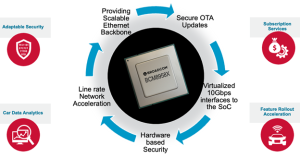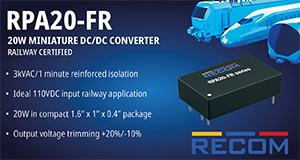Courtesy : Broadcom
Broadcom’s portfolio of automotive Ethernet switches are built not only for today’s automotive network, they’re scalable for the network of the future.
Automakers have used Broadcom’s standard automotive switches for more than a decade to route data between various sensors, processing units, and actuators within the vehicle. As automakers transition from domain-based to zonal architectures, pre-planning allows the architectures to scale to newer features and benefits.Software-defined vehicles, or SDVs, have the connectivity and processing power to secure, monitor, upgrade, and update vehicle capabilities. The software for different computing functions, such as driver assist, infotainment, body control, and instrumentation, can all be distributed across different boards and processors. Sensor data can flow to multiple zones/boards versus being directly connected. It is the scalability of Ethernet hardware that allows an SDV to be improved after purchase. So, what features should you look for in a switch to support SDVs?

The first item to examine is the type of system on chip, or SoC, that is being used for compute processing in your architecture. New classes of automotive SoCs allow application processing, real-time processing, AI compute, and safety functionality in a single device. Zonal and central compute electronic control units (ECUs) can take advantage of these scalable SoCs. These SoCs have multiple multi-gigabit interfaces to the network to gather and transmit all the data they need to process. For example, AI models for autonomous drive systems can be updated to improve camera recognition and safety. As new software features are added, the amount of data sent over these SoC interfaces will increase. Just as the SoCs are optimized and designed to scale over time to handle larger compute and network needs, the Ethernet network must be designed from the start to support future needs. The automotive Ethernet switch must support multiple connections to the SoCs at the maximum line rate needed. The switch should also be able to support the scalability of each interface from 1Gbps to 10Gbps. If the SoC supports PCIe interfaces with virtualization, then the switch needs to support virtualization as well.
As the software feature workloads get distributed between compute devices, there will be a need for network performance optimizations and time-sensitive provisioning. SDVs will collect data across the network for data analytics and health monitoring. The Ethernet switches will use their packet filters to monitor specific traffic flows at line rate. Captured motor efficiency data, Ethernet network health, and autonomous drive data for AI model improvement can all traverse the Ethernet backbone to the car’s cloud connection. Dynamic configuration of the automotive Ethernet switches allows the automaker to scale the needed resources efficiently over time. Automotive Ethernet switches need to have the bandwidth scalability and timing control to handle future network needs.
As port count requirements for an ECU increase, the automotive Ethernet switch chip must be able to handle all the ports with a single die. A switch chip that uses more than one smaller switch die in a single package can cause numerous issues. The stacking or cascading switch cores have higher latency as the Ethernet packets must be stored and forwarded through each switch die. The high-speed interface between these embedded dies becomes a bottleneck for traffic that must flow from a port on one die to the port on the other die. Time synchronization becomes trickier as multiple gPTP protocol stacks are run inside the single package. Scalability is a key feature enabled effectively with a monolithic die based switch.
As mentioned in our blog,”Securing software-defined vehicles with zonal E/E architectures,” protecting SDVs using zonal electrical/electronic architectures is critically important. The SDV architecture requires a multilayer security approach. The switches need to boot authenticated images securely, and they must allow only authenticated images to be loaded during over-the-air updates. Since software-based protection is challenging at faster Ethernet speeds, MACsec packet authentication and encryption allows line-rate protection in hardware at speeds up to 10 Gbps. In addition, both DOS protection and packet filtering are needed in hardware. Additional levels of protection can be taken in hardware that are unique to an automotive network architecture. An automotive network is fixed, unlike an SMB or enterprise Ethernet network. A port on the switch connected to a RADAR will always be connected to that RADAR in every car. If the unique address of the RADAR on an Ethernet packet is ever seen ingressing on another port, then it is known that someone is spoofing that address, and the port should be quarantined. The same can be said if a second address is seen on the RADAR port, as there should only be one device connected to that port. The security features should be implemented by dedicated hardware in the switch with software running on the internal processor subsystem handling any exceptions. This enables all of the security functionality at line rate and makes the intrusion detection and prevention software clients to be efficient and effective.
50G Auto Ethernet Switch Portfolio Expansion
In 2022, Broadcom unveiled the 50G automotive Ethernet switch product family to meet automakers’ needs and enable the future of SDVs. To drive mass adoption of SDVs, Broadcom is expanding the product family with a new cost-optimized 11-port version, the BCM89581MT. This device is a single die, lower-power, smaller-port count, 50G automotive Ethernet switch. To provide scalable flow of traffic, the BCM89581MT has multiple interfaces capable of 10Gbps connections to the latest SoCs and multi-gigabit automotive Ethernet PHYs. The high-speed interfaces can be 2.5G SGMII, USXGMII, PCIe Gen 4 single lane or XFI. This addition to Broadcom’s automotive Ethernet switch portfolio will allow for smaller port count central compute or zonal ECUs to fit into the SDV architecture. Broadcom’s automotive SDK can be seamlessly ported across the different family members.
The BCM89581MT enables original equipment manufacturers (OEMs) to realize the full network potential for smaller cost-optimized ECUs. With advanced security, scalable connections to SoCs, advanced time-synchronized networking features, and a full-feature SDK, the BCM89581MT easily allows the OEM to take advantage of the SDV features they need. Broadcom will showcase its expanded portfolio of 50G automotive Ethernet switches, including the new BCM89581MT, at the 2025 Automotive Ethernet Congress in Munich from February 18th-20th. Stop by our booth to learn more about our latest offerings and how our expanded portfolio of automotive Ethernet switch chips enable next-generation software-defined vehicles.









